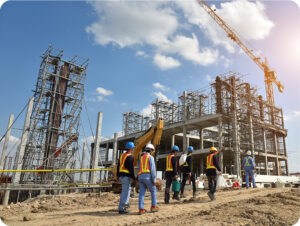Economic Outlook for US Economy In Q4 2023 and Beyond
The Relentless Strength of the U.S. Economy Expected to Continue in Q4
The U.S. economy is going strong in 2023, regardless of economic uncertainties. The main factors driving U.S. economic growth are strong consumer spending and low unemployment. The U.S. economy is among the strongest in the G7.
The U.S. economy has
- Regained all pre-pandemic GDP losses in 2021.
- Surpassed pre-pandemic levels.
- A size that’s over 5% above its 2019 level.
- Core inflation that’s lower than in many major advanced economies.
- A strong labor market recovery.
 The balance between achieving economic growth and maintaining a stable labor market while simultaneously managing broad disinflation is incredibly difficult and historically rare. The tightening in bank lending has not yet choked-off the growing economy, however business loan demand has remained weak in the months following March’s bank failures. Strong economic data combined with diminishing inflation is pointing financial markets pricing in fewer and less aggressive short-term rate cuts next year.
The balance between achieving economic growth and maintaining a stable labor market while simultaneously managing broad disinflation is incredibly difficult and historically rare. The tightening in bank lending has not yet choked-off the growing economy, however business loan demand has remained weak in the months following March’s bank failures. Strong economic data combined with diminishing inflation is pointing financial markets pricing in fewer and less aggressive short-term rate cuts next year.
According to Morgan Stanley, real GDP growth is forecast to be 1.3% in the fourth quarter of 2023. Fannie Mae predicts 1.9% growth in the fourth quarter. Consumer spending which drives 65% of GDP has been resilient throughout the year. If consumer spending moderates in Q4, growth could slow to low levels by early next year.
A soft landing may yet be within reach, but the time-lapsed effects of tightening monetary policy have not yet been felt through all corners of the economy.
Key Takeaways
- Government investment in Infrastructure drives equipment sales
- A recession in the remainder of 2023 is unlikely.
- Bonds up, stocks down
- Consumer spending has weathered higher rates so far this year.
- As core inflation reduction continues to make progress, expect a slowing economy to lower Consumer Price Index (CPI) inflation to 2.5% in Q1/Q2 of 2024.
- As disciplined as the Fed have been, expect the rate hikes to ease.
- Savings rate fell to 3.5% in July suggesting consumers spend out of savings.
Are the Feds Done Hiking Rates?
 The Federal Open Market Committee (FOMC) held rates steady during their most recent meeting in September 2023. In July, the Feds raised interest rates to 5.25%–5.50% which was the 11th rate hike aimed at curbing high inflation. They’re giving themselves time to evaluate if the current rates are effective at keeping inflation at bay without hampering economic growth.
The Federal Open Market Committee (FOMC) held rates steady during their most recent meeting in September 2023. In July, the Feds raised interest rates to 5.25%–5.50% which was the 11th rate hike aimed at curbing high inflation. They’re giving themselves time to evaluate if the current rates are effective at keeping inflation at bay without hampering economic growth.
Monetary policy has been restrictive for several months now, signs point to the hiking cycle nearing its end. TheFed’s efforts to subdue inflation without over-stimulating the U.S. economy grows increasingly complicated given recent jobs numbers. Further Fed rate cuts are not imminent given our continued economic strength. Anticipate a significant growth slowdown to take hold in early 2024 influenced by the auto strike, restart of student loan payments and the likelihood of another threatened government shutdown.
The next Federal Open Market Committee (FOMC) meeting will be held on October 31-November 1, 2023. The Fed held rates steady at 5.25%-5.50% at its September 2023 FOMC meeting, a “hawkish pause” that provided some relief for a strained banking sector and tepid stock market. Given the risks of bank failures, a tepid stock market, and global economic instability, the Feds may continue to press the hold button for the next couple of months.
The Job Market: Slow down? What Slow Down?!
 Job growth was better than expected in September. The U.S. economy is resilient despite higher interest rates, labor strife and dysfunction in Washington. Nonfarm payrolls increased by 336,000 for the month of September, better than the Dow Jones consensus estimate for 170,000.
Job growth was better than expected in September. The U.S. economy is resilient despite higher interest rates, labor strife and dysfunction in Washington. Nonfarm payrolls increased by 336,000 for the month of September, better than the Dow Jones consensus estimate for 170,000.
Considering overall job growth, there’s nearly 2.34 million jobs created so far this year and that’s after just nine months, not yet the entire calendar year. According to the latest numbers, the U.S. economy has created roughly 14.4 million jobs since January 2021.
Our Job Growth In Context:
- 2016: 2.3 million
- 2017: 2.1 million
- 2018: 2.3 million
- 2019: 2 million
- 2020: -9.3 million
- 2021: 7.3 million
- 2022: 4.8 million
- 2023 (so far): 2.3 million
The resilience of the labor market could impact the Federal Reserve’s decision on whether more rate hikes will be necessary to bring inflation under control. Policymakers contend a tight labor market will continue to put upward pressure on wages which then will push prices higher.
The unemployment rate in September held at 3.8%. The sizable pool of available labor places downward pressure on wage growth which ticked lower to 4.2% year-on-year in August. The Quits Rate, an indicator of worker confidence, fell to roughly its pre-pandemic rate of 2.4%. Initial jobless claims remain historically low at approximately 230,000.
“The September jobs report mirrored other recently released employment metrics and confirmed that the labor market remains resilient,” said Shawn Snyder, Global Investment Strategist for J.P. Morgan Wealth Management. “With the economy adding 336,000 jobs, the three-month average employment gain has been 266,000 jobs. That pace is more than sufficient to keep the unemployment rate from rising.”
The Big Quit is officially over. Americans quit their jobs at a consequentially slower rate this summer after a record high number of resignations earlier in the pandemic which was a disturbing historic trend for the economy. In each of the past three recessions the Quits Rate fell. Quitting is a sign of discontent with an employer, but also indicates confidence that the employee can find another position. When this rate falls, workers may be worried about their prospects.
Americans may also stay with their jobs for other reasons, including greater flexibility, better pay or perhaps they are satisfied with their current situation. That may suggest that fewer quitting isn’t necessarily an indication of an economic downturn and the expansion could have staying power.
 Pandemic-related worker shortages triggered record job openings and wage growth. That has drawn in women who left the workforce during the pandemic.
Pandemic-related worker shortages triggered record job openings and wage growth. That has drawn in women who left the workforce during the pandemic.
Women were negatively impacted by job losses early in the pandemic crisis and are now benefitting from a robust recovery as well as the wider availability of child care, remote work options and other factors.
Their return to work has helped boost the broader U.S. labor force participation rate from 60.1% early in the pandemic to 62.6%. More workers has made it easier for companies to attract employees and slowed sharp wage growth, helping ease a historic inflation spike.
Women aren’t just looking for new positions – they’re landing them. Up to this point in 2023, the pool of 25- to 54-year-old women working or job hunting has swelled by 815,000 after a gain of 448,000 in 2022.
Flexible work options enable job growth. According to the Pew Research Center, about 35% of employees who can do their jobs remotely are working from home, up from just 7% before the pandemic.
Into 4Q – The Bond Market Is In The Driver’s Seat
With stocks taking a back seat, the bond market is driving, a trend that accelerated after the Labor Department reported a jump in job openings for August. Just when you think the party (2023 Market Rally) will never stop, Q3 drives up and spoils the fun. As yields on longer-term government bonds grew, the advance of a stock market powered by richly valued technology shares tapped the brakes. The S&P 500, which was up nearly 20% for the year just a couple months ago is now grasping to maintain a 12% increase.
There are concerns that a still-hot economy could keep Federal Reserve policy tight. Investors heading into Q4 of 2023 are worried the Federal Reserve will keep interest rates higher for longer than they expected, potentially undermining assets like stocks and increasing the likelihood that an apparently resilient economy may run into trouble. Another rate hike before the end of the year is an open question, rates are almost certain to stay at an elevated level for an undetermined period of time. Higher interest rates raise the cost of capital and run counter to the easy monetary policy that has supported Wall Street success for over the last decade.
“The huge upside surprise in the monthly jobs report blew any ideas about a cooling labor market out of the water,” said Mike Loewengart, head of model portfolio construction at Morgan Stanley Global Investment Office. “Regardless of whether another hike occurs, investors are facing the prospect of a hawkish Fed and high interest rates for the foreseeable future.”
Subdued Housing Market
Increasing mortgage rates will apply downward pressure on sales. It’s uncertain “if or “when” a pending recession is on the horizon, but a recent Fannie Mae Economic Outlook places their guess in the first half of 2024. Whether a soft landing is manageable in 2024, expect existing home sales to be suppressed and within a narrow range.
Census data shows signs of deceleration in Multifamily construction. Multifamily permits have been trending downward for months at an annual decline of 31%. Unlike in single-family housing, the Multifamily vacancy rate returns to pre-pandemic level .
Expect a continued pull-back in multifamily housing starts in Q1 and Q2 of 2024, due to credit standards tightening for construction and development as well as for commercial real estate (CRE) loans.
 Construction In 2023 Was Robust
Construction In 2023 Was Robust
Supply chain performance has improved significantly since Q3 2022. Supply chain pressures have dissipated, with lower shipping costs, greater container ship capacity and shorter delivery times. This reflects a system with greater free capacity and faster performance times. This enabled more construction spending in 2023 and is forecast to reach $1,915 billion by year’s end, an increase of 6.4% over 2022. However, spending gains are expected to moderate and decline slightly in the fourth quarter of 2023.
Examples of construction projects include efforts by Intel and General Motors. Intel is building two chip factories in Ohio with an investment of more than $20 billion. Phase 1 of the project is estimated to create 3,000 intel positions and 7,000 construction jobs. The construction began in 2022 and is expected to be complete in 2025. Additionally, General Motors Co. is investing $7 billion in developing four manufacturing factories in Michigan. The investment would create 4,000 new jobs.
 Material costs in 2023 stayed high when compared to previous years, but there is some stability for building and construction materials after years of significant fluctuations. By August 2023, costs for lumber had decreased by 24% year to date (YTD). Prices for lumber, steel pipe and aluminum have seen double-digit decreases in the past year, however concrete, glass, gypsum, and insulation have experienced double-digit increases. Demand for construction will probably keep those costs elevated throughout 2024. Construction costs may have peaked. The expectation is every category will reach a “normal” rate of price change in 2024.
Material costs in 2023 stayed high when compared to previous years, but there is some stability for building and construction materials after years of significant fluctuations. By August 2023, costs for lumber had decreased by 24% year to date (YTD). Prices for lumber, steel pipe and aluminum have seen double-digit decreases in the past year, however concrete, glass, gypsum, and insulation have experienced double-digit increases. Demand for construction will probably keep those costs elevated throughout 2024. Construction costs may have peaked. The expectation is every category will reach a “normal” rate of price change in 2024.
Inflation impacts the cost of construction including materials, labor, and land. Challenges posed by labor shortages may offset potential material cost savings. Demand for contractor labor may outpace supply. As of June 2023, there were 374,000 open positions in construction and 346,000 hires, highlighting the continued high demand for workers in the industry.
 The industry remains challenged by an aging workforce. More than 1 in 5 construction workers is 55+ years old and as those workers retire, the labor pool is expected to shrink even more unless the industry manages to attract fresh talent. Perhaps ultimately, it’s the ongoing skilled labor shortage and the high cost of labor that could blunt 2024’s momentum.
The industry remains challenged by an aging workforce. More than 1 in 5 construction workers is 55+ years old and as those workers retire, the labor pool is expected to shrink even more unless the industry manages to attract fresh talent. Perhaps ultimately, it’s the ongoing skilled labor shortage and the high cost of labor that could blunt 2024’s momentum.
Despite ongoing economic volatility, 2023 looked strong for the commercial construction market. It’s 2024 that you need to keep an eye on. High interest rates are a concern and banks are tightening lending requirements.
Construction Equipment Sales
The U.S. compact construction equipment market is projected to be driven by government investment in the real estate sector and other infrastructure development and maintenance projects as we move into 2024. The U.S. government continues to invest in renewable energy resources with the goal to produce 95GW of power from renewable resources such as solar, wind, and geothermal by 2025. This is a factor which is fueling the demand for compact construction equipment market.
The North America compact construction equipment market size was estimated at 231.7 thousand units in 2022 and is expected to reach 317.9 thousand units by 2029, growing at a Compound Annual Growth Rate (CAGR) of 4.62%.
This includes
- Excavators
- Backhoe Loaders
- Wheel loaders
- Track loaders
- Skid steer loaders
- Telehandlers
- Forklifts
- Aerial platforms
- And others
 This would apply to
This would apply to
- Material handling
- Maintenance and utility works
- Waste management
- Construction
- Mining
- Warehouse and logistics
- And other industries
Key Vendors
- Caterpillar
- Komatsu
- Xuzhou Construction Machinery Group Co. Ltd. (XCMG)
 Volvo Construction Equipment
Volvo Construction Equipment- Hitachi Construction Machinery
- JCB
- SANY
- Kobelco
- Hyundai Construction Equipment
- John Deere
- Zoomlion Heavy Industry Science & Technology Co. Ltd
- Kubota
- Doosan
- Bobcat
- And others
For example, Deer & Company’s Equipment sales increased 12% across three main divisions (Production and Precision Agriculture, Small Agriculture and Turf, and Construction and Forestry) the company citing strong order books and favorable pricing.
“Reflected by our strong third-quarter results, Deere continues to benefit from favorable market conditions and an operating environment showing further improvement,” said John C. May, chairman and chief executive officer. “We are also being helped by stabilizing conditions in the supply chain, the sound execution of our business plans, and an improving ability to meet demand for our products and serve customers.”
“Fundamentals are expected to continue fueling solid demand for our equipment, supported by a strong advance-order position. At the same time, through the company’s smart industrial operating model, we are delivering differentiated value to our customers, enabling them to do their jobs more profitably and sustainably.”
The demand for compact track loaders is growing quickly in the equipment market. Track loaders made up the largest market share of the U.S. compact construction equipment market in 2022. Compact track loaders and compact excavators have the highest demand in North America. This equipment generates nearly 68% of all compact equipment sales.
Compact backhoes and wheeled loader sales are growing steadily in 2023. Some major manufacturers such as JCB & Caterpillar have launched a new compact backhoe loader equipped with the latest technology for the market in 2023.
The growing trend of electric compact equipment is undeniable. Manufacturers are diversifying product offering and starting to focus on electric equipment. For example, Wacker Neuson announced it’s launch of an electric mini excavator, the EZ17E, in the U.S. in 2024, and Volvo CE launched the EC230 electric excavator in 2022. XCMG Construction Equipment launched a range of electric compact excavators, as well.
XCMG, Zoomlion, LiuGong, Kobelco, JCB, and Hyundai Construction Equipment are flexing in the U.S. market. They are introducing new technologically advanced products to challenge the share of market leaders in the compact construction equipment market.
 The construction equipment market is expected to grow steadily due to the rise in government investment in public infrastructure & housing projects. This year, the U.S. government promoted investments worth $1.2 billion in nine major infrastructure projects under National Infrastructure Project Assistance. These project aims to create jobs, strengthen the supply chain, and improve the mobility & safer transport system across the country.
The construction equipment market is expected to grow steadily due to the rise in government investment in public infrastructure & housing projects. This year, the U.S. government promoted investments worth $1.2 billion in nine major infrastructure projects under National Infrastructure Project Assistance. These project aims to create jobs, strengthen the supply chain, and improve the mobility & safer transport system across the country.
Infrastructure upgrade projects like the renovation of commercial buildings, railway stations, airports, repair of runways, and extension of roadways and bridges in rural parts of the region drive high demand for compact construction equipment in the North America compact construction equipment market.
Volatility stemming from the regional banking hesitancy to lend has largely diminished, but uncertainties remain around the sector’s lending growth outlook. Slower loan growth from regional banks could be a detriment to equipment sales giving some opportunity to the rental market.
Construction Rentals
The U.S. construction equipment rental market size was valued at $39.2 billion in 2022 and is expected to reach $54.17 billion by 2029. That market share is expected to grow at a Compound Annual Growth Rate (CAGR) of 4.73% from 2022-2029.
Earthmoving Equipment
 Excavator
Excavator- Backhoe Loaders
- Wheeled Loaders
- Bulldozers
- Trenchers
- And others
Material Handling Equipment
- Crane
- Forklift and Telescopic Handlers
- Aerial Platforms
- Articulated Boom Lifts
- Telescopic Boom lifts
- Scissor lifts
- And others
This applies to these industries
- Construction
- Logistics and Warehouse
- Mining
- and others
Warehousing Demand Is Growing
The growth of the E-commerce industry prompts investment in warehouse expansion. The surge in warehouse expansion projects in 2023 supports the sales of compact forklifts and telehandlers.
According to the U.S. Department of Commerce, online purchases accounted for 15.1% of total U.S. retail sales in Q1 2023. Online shopping increased by 14.8% in Q1 2023. The rise in online shopping promoted investment in warehouse expansion projects in 2023.
With an increased focus on eliminating carbon emissions from various sources to achieve the goal of carbon neutrality, investment in green warehouse projects expanded in 2023. This rising trend of green warehouses and factories increases demand for compact equipment equipped with electric technology in the U.S. compact construction equipment market. In 2023, Manitou Group launched the MRT2260e, MRT 2260e Vision+, and MT 625e electric telehandlers.
Clean Up On Aisle 3
Strong economic growth, establishment of new businesses, company expansions, and increased construction activities are mainly driving the demand for cleaning services in the U.S.
 The global commercial scrubbers and sweepers market size was valued at $5.10 billion in 2022 and is expected to reach $8.04 billion by 2028. The U.S. accounted for the largest market share with 31%.
The global commercial scrubbers and sweepers market size was valued at $5.10 billion in 2022 and is expected to reach $8.04 billion by 2028. The U.S. accounted for the largest market share with 31%.
In commercial places such as shopping malls, airports, railway stations, healthcare facilities, and educational institutions, where regular cleaning and maintenance are necessary, commercial floor scrubbers and sweepers are necessary to provide efficient cleaning. The market for floor scrubbers and sweepers is expected grow throughout 2024.
The walk-behind scrubbers accounted for the largest commercial scrubber market share, however the commercial ride-on sweeper segment is projected to grow fastest in 2024.
The advancement of autonomous and robotic cleaning technology has forever changed this market. Adopting automation and robotic technologies is significantly changing the overall cleaning industry. Labor cost account for approximately 95% of the cleaning cost and the use of robotics can greatly reduce the cost of cleaning. Recent rapid technological improvements have promoted the emergence of new technologies in the cleaning process. The growth of automation and robotics in commercial floor cleaning is transformational with rising adoption in industries such as warehouse and distribution, airports, and other high-traffic areas.
The dominate players in the commercial scrubbers and sweepers market include Nilfisk, Tennant, Kärcher, Hako, and Factory Cat. Nilfisk and Tennant mainly produce high-end professional cleaning products, while Kärcher produces both high-end and mid-market products.
Looking forward, with innovations in battery technology, the demand for battery-powered scrubbers & sweepers is expected to grow. The rapid technological improvements adversely impact manufacturers as consumers expect continuous innovations and product upgrades. This demand for new technology challenges vendors to refine their unique value propositions to achieve stronger market presence.
The dominate trends in the commercial scrubbers and sweepers industry are growing demand for green cleaning technologies, availability of robotic cleaning equipment, growing inclination toward sustainability, growing demand in warehouse & distribution facilities, and consistent growth in the construction market.
Infrastructure Drives Economic Growth
The U.S. government is investing in the construction sector to strengthen economic activities and employment. The government plans to invest $1.2 trillion under the U.S. Bipartisan Infrastructure law in 2021 for the next ten years. $550 billion was allocated for infrastructure development projects for the next five years. An investment of $284 billion and $266 billion was planned for transport & public infrastructure development, respectively, in 2021.
The Department of Transportation (FHWA) requested $60.8 billion for the fiscal year 2024. When combined with $9.5 billion in advance appropriations from the Infrastructure Investment and Jobs Act (IIJA), the total budget is $70.3 billion.
The Federal Aviation Administration (FAA) announced an expenditure of $3 billion for 3,075 U.S. airports to improve their terminals. The US Army Corps of Engineers (USACE), floated $3.9 billion to improve supply chains and strengthen ports and waterways. This includes more than 16 construction projects across 10 states.
“There is no way we could’ve ever built this project with traditional federal and state funding programs,” said Larry Krauter, chief executive of Spokane International Airport. “It’s a real game-changing grant.”
 Under the Rural program, the U.S. government will invest nearly $2 billion in infrastructure development programs across rural areas until 2026. These infrastructure investments will enhance highways, bridges, and tunnels and address highway safety issues. In addition, such projects will boost access to agricultural, commercial, energy, or freight facilities that support the economy and offer flexible transportation services to rural regions which creates new opportunities for growth in underserved areas.
Under the Rural program, the U.S. government will invest nearly $2 billion in infrastructure development programs across rural areas until 2026. These infrastructure investments will enhance highways, bridges, and tunnels and address highway safety issues. In addition, such projects will boost access to agricultural, commercial, energy, or freight facilities that support the economy and offer flexible transportation services to rural regions which creates new opportunities for growth in underserved areas.
Approximately $60 billion would be invested by the government to repair surface transportation nationwide.
Development of a high-speed rail system in California includes 800 miles of rail with up to 24 stations. The project will connect San Francisco to Los Angeles, extending to Sacramento and San Diego. The rail would run along 799.7 miles and is estimated to be completed in 2033. This project is the first high-speed train system implemented in the U.S. It is estimated to cost $68 billion, and the investment by the federal includes $2.6 billion in state bonds.
“We’ve seen exponential growth from infrastructure funding,” said Daoud Chaaya, vice president of sales and marketing at Thomas Built Buses, which is part of Daimler Truck North America. “It’s been the biggest propeller of exploding demand.”
The services provided by infrastructure assets are essential for the functioning of a society. Critical to a growing economy, infrastructure spending on transportation, power, and water facilities are public goods that benefit and connect everyone. Promoting infrastructure projects contributes to higher productivity and growth, facilitates trade and connectivity, and promotes economic inclusion.
Conclusion
The U.S. economy has continued to grow during the first half of 2023 despite a multitude of economic risks. By many metrics it has outpaced its competitor countries by recording the lowest inflation rate and the strongest economic recovery in the G7. The U.S. has made a comparatively quick recovery from the COVID-19 pandemic. The U.S. economy is well-positioned and additional economic investments should help ensure that its economic future remains strong.
A Results Driven Equipment Finance Company
With a track record of success, Commercial Capital Company is proud to have funded millions of dollars in small business financing, helping businesses across nation in various industries achieve their goals.
We specialize in providing affordable equipment loans and leases to businesses in construction, manufacturing, transportation/logistics, healthcare, agriculture, food services, technology and IT to name a few.
Secure the equipment financing you need to propel your business forward.
Contact Us
13910 W 96th Terrace
Lenexa, KS 66215
Toll Free: (800) 878-8053
Direct: (913) 341-0053
E-mail: sales@ccckc.com
We’re a Veteran Owned Business.
We proudly support our nation’s veterans. Find us on Veteran Quote.



